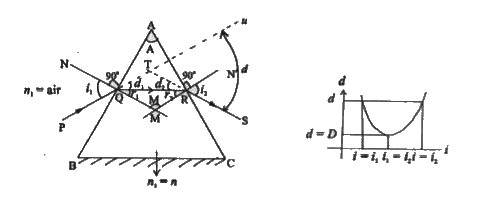Show that n=sin(A+D2)sin(A2) where symbols have their usual notations. Solution in Kannada
BC - Base of the prism
AB and AC - Refracting sides representing the planes
ABC - Principle section of prism.
PQ - incident ray.
RS - emergent ray
d1 - angle of deviation d1=i1−r1
d2 - angle of deviation d2=i2−r2
uˆTS- d - total angle of deviation or net deviation
i.e., d=d1+d2 (exterior angle = sum of two opposite interior angles)

NM is normal to AB at Q
N.M is normal to AC at R
i1- angle of incidence
i2 - angle of emergence.
D = angle of minimum deviation,
From figure (1)
From the quadrilateral AQMR,
AˆQM≅AˆRM=90∘ (Nm, N.M are normal to AB and BC)
So that A+M=180∘ ......(1)
∴AQMR is a cyclic quadrilateral. From the triangle QMR
r1+r2+ˆM=180∘(Property of a Δ) ......(2)
From (1) and (2)
A+M=r1+r2+M
i.e., A=r1+r2 .......(3)
For non-symmetric condition i1≠i
d1≠d2 also net deviation d.
d=d1+d2
d=i1−r1+i2−r2
∴d=i1+I2−(r1+r2)
using (3) we write,
d=i1+i2−A .......(4)
from the fig., we note that for non-symmetric condition for two angles of incidence, angle of net deviation is the same. However for a symmetric condition, i1=i2=iandr1=r2=r net deviation becomes the minimum angle of deviation. In this case the refracted ray will be parallel to the base.
∴ for symmetric condition,
(4) can be written as D=2i−A
i.e., i=(A+D2) ......(5)
(3) can be written as,
A=2r
or r=(A2) ......(6)
From Snell.s law of refraction at AB,
Topper's Solved these Questions
- BOOK - SUBHASH PUBLICATIONCHAPTER - RAY OPTICS AND OPTICAL INSTRUMENTSEXERCISE - NUMERICALS WITH SOLUTIONS22videos
RAY OPTICS AND OPTICAL INSTRUMENTS
- BOOK - SUBHASH PUBLICATIONCHAPTER - RAY OPTICS AND OPTICAL INSTRUMENTSEXERCISE - TWO MARKS QUESTIONS WITH ANSWERS59videos
RAY OPTICS AND OPTICAL INSTRUMENTS
- BOOK - SUBHASH PUBLICATIONCHAPTER - QUESTION PAPER 2019EXERCISE - PART - C6videos
QUESTION PAPER 2019
- BOOK - SUBHASH PUBLICATIONCHAPTER - SEMICONDUCTOR ELECTRONICSEXERCISE - OPTIONAL NUMERICALS WITH SOLUTIONS6videos
SEMICONDUCTOR ELECTRONICS
Similar Questions
Show that lateral shift is equal to the thickness of the slab for grazing incidence.
04:14View SolutionState the laws of reflection of light.
02:56View SolutionDerive an expression for potential energy of electric - di-pole placed in a n uniform electric field .
02:08View SolutionIf the peak value voltage in the secondary output ac voltage is 12V, then what will be the average DC in the case of HWR and FWR?
02:22View SolutionWith the usual notation in a DeltaABC,|(1,1,1),(sin A,sin B,sin C),(sin^2 A,sin^2 B, sin^2 C)|=
04:05View SolutionIn Delta ABC with usual notation,if R^(2)(sin A sin B+sin B sin C+sin C sin A)=3, then The minimum value of (a^(2)+b^(2)+c^(2)) is
03:32View SolutionIn ΔABC, with usual notations, bsinB−csinCsin(B−C)=. . . .
05:42View SolutionIn △ABC , with the usual notations , prove that 2{asin2.C2+csin2.A2}=a+c−b
07:53View SolutionS.T f=R2 in the case of a spherical mirror where symbols have their usual notations
01:44View SolutionWith the usual notation in ΔABC det∣∣ ∣ ∣∣111sinAsinBsinCsin2Asin2Bsin2C∣∣ ∣ ∣∣ assumes the value
04:05View SolutionShow that alpha = beta/2 where symbols have their usual meaning.
01:44View SolutionShow that x=ut+12at2graphically, where symbols have their usual meaning
View SolutionShow that n=1sinC where symbols have their usual notation.
04:02View SolutionS.T f=R2 in the case of a spherical mirror where symbols have their usual notations
05:12View SolutionIn a triangle ABC (with usual notations),(sinA+sinB)sinC=a.b2R2 ,then which of the following are always true-
04:05View Solution

